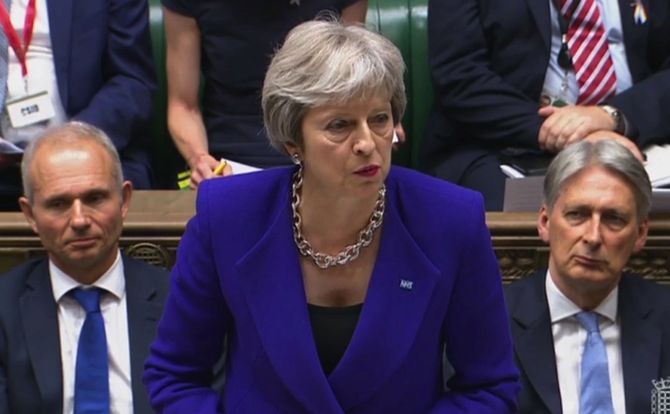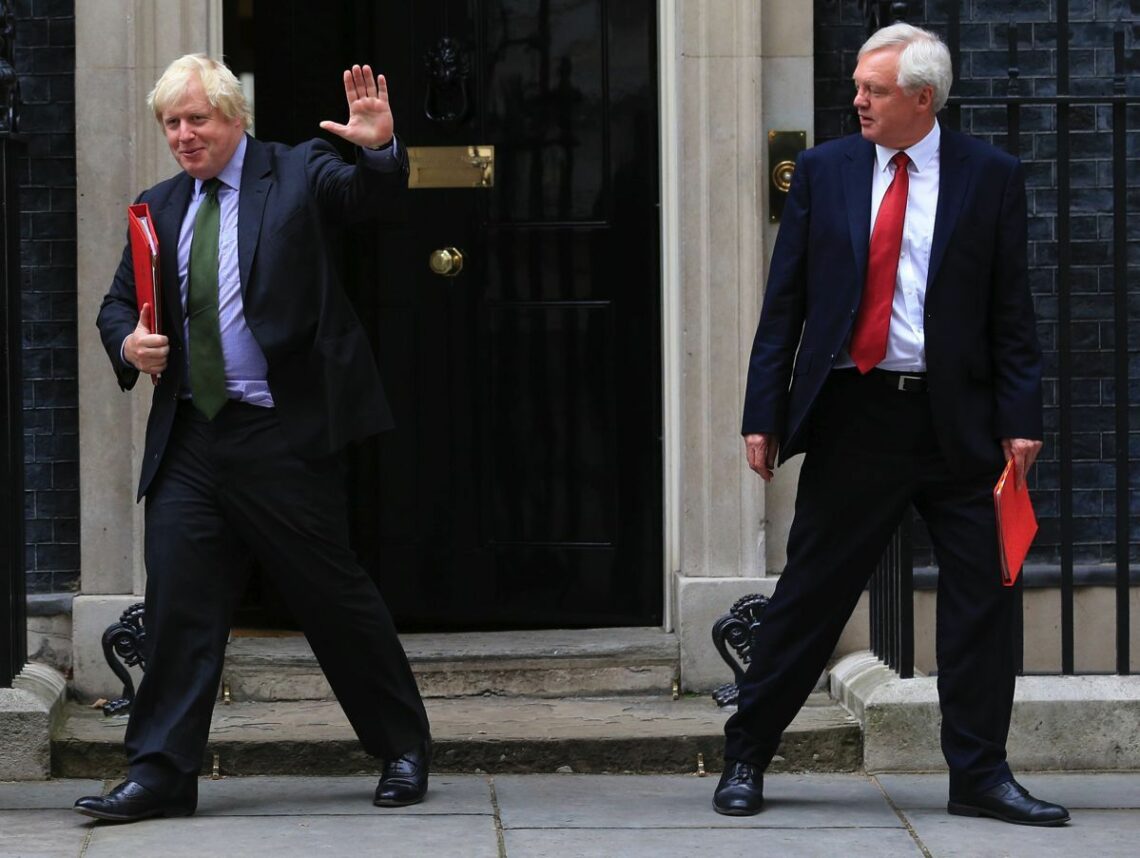Brexit scenarios: Toward the endgame
Prime Minister May has bowed to economic reality and unveiled a Brexit model that would keep the UK close to the EU. The move provoked an cabinet crisis and the resignations of leading Brexiters. Fear of a Labour government will keep other Conservatives in line, but Ms. May’s survival hinges on the EU accepting her new strategy.

In a nutshell
- Theresa May’s political weakness has all but ruled out a smooth conclusion to Brexit talks
- A “cliff edge” scenario with no Brexit agreement reached is now plausible
- Prolongation of talks or an open-ended transition seems more and more likely
British Prime Minister Theresa May has finally bowed to economic reality and imposed on her fractious cabinet a Brexit model that would keep the United Kingdom close to the European Union. Her decision provoked the resignations of David Davis, the minister in charge of the Brexit negotiations, and Foreign Secretary Boris Johnson, who denounced it as a “semi-Brexit” that betrayed those who voted to leave in the June 2016 referendum.
Ms. May’s hold on power is precarious and other resignations might follow. She could face a leadership challenge within the Conservative Party, but for now, the numbers in parliament are lacking for a vote of no confidence. Her trump card against insurgent Brexiters is fear that her overthrow would bring a Labour cabinet to power with Jeremy Corbyn at its head.
The political survival of Ms. May now depends on the EU accepting her new Brexit model as a basis for negotiation. If Brussels rejects it, she could not stay on as prime minister. More uncertainty would be cast over the exit talks, with Britain’s official departure date of March 29, 2019 barely eight months away.
The new proposal bases Britain’s future relations with the EU on an Association Agreement, involving a Free Trade Agreement (FTA) and a hybrid customs cooperation scheme designed to preserve just-in-time supply chains, keep trade flowing seamlessly, and avoid a “hard” border across Ireland. The arrangement would cover industrial and agricultural goods but not services. Ms. May claims that it would leave Britain free to conclude its own trade agreements with countries around the world.
By dropping demands for unimpeded access to the EU’s single market for British services and avoiding a hard border in Ireland, Ms. May calculates that she will earn sufficient credit for Brussels to accept her proposal as a basis for talks. John Bruton, a former Irish prime minister, told the author of this report, “The risk of a ‘no deal crash-out’ has receded. It now becomes a conventional negotiation.”
Brexiters accuse Ms. May of selling out while moderates fear the new formula will again be rejected by the EU.
However, Brexiters are accusing Ms. May of “selling out” while moderates fear that the new formula will again be rejected by the EU as “cherry-picking” the single market. Business circles question the feasibility of the cumbersome dual tariff customs proposal and lament the exclusion of services, which account for 32 percent of British exports to the EU.
The first reaction by the EU’s chief negotiator, Michel Barnier, was encouraging. But French observers pounced on Ms. May’s proposal, criticizing it for splitting the single market between goods and services. Her plan continues to reject a pillar of the single market – the free movement of workers. Berlin may be more accommodating. But the EU will hesitate to engage with Ms. May before the Conservative Party conference in October shows whether she still has a mandate.
Such uncertainties point to the very real possibility of a chaotic or “hard” Brexit. Faced with this risk, many multinational companies, including Airbus and BMW, are adopting a “no-regrets” policy, delaying investment decisions or shifting their activities to other jurisdictions. Ms. May’s proposals are unlikely to stem this outflow.
What, then, are the most likely scenarios for the endgame?
1. Smooth and sensible
The title of the first scenario is borrowed from a phrase used last year by Prime Minister May to describe how Brexit should work, if both sides are responsible.
If both sides prove ready to engage and compromise in the months ahead and good progress is made, the withdrawal agreement, including a 21-month transitional period, and a political declaration setting out the principles governing future relations could be drawn up by the end of the year. That would allow time for formal approval ahead of the UK’s scheduled exit on March 29.
For the next 21 months, very little would change. Britain would continue to make payments to the EU budget, respect the jurisdiction of the European Court of Justice and accept the free movement of labor until December 31, 2020. But, as a nonmember, it would lose any say in decision-making, while remaining bound by the EU’s decisions during the transition period.
The prime minister’s vow to make Brexit work smoothly is almost impossible to fulfill in the limited time available.
Once Britain has ceased to be an EU member, negotiations would begin on an FTA in line with Ms. May’s July proposal. With Brexit already a reality, the UK may gravitate toward a customs union with the EU (and de facto single-market membership) as the only sustainable means to avoid disrupting trade and erecting a hard border across Ireland. British political leaders and public opinion would quietly drop the notion of a “global Britain” concluding ambitious trade agreements with countries across the globe.
The trade aspects of this future partnership could probably be brought into effect provisionally around 2022, pending ratification of cooperation in other areas such as security and defense.
However, this optimistic scenario could easily be derailed – by more Conservative resignations, a parliamentary defeat on the withdrawal legislation, a no-confidence vote, a leadership change, or an early general election. The Labour Party may come to power with new priorities, including support for a Customs Union, but also with sharp divisions in its own ranks. This could paralyze the Brexit talks. The EU’s negotiating position is also vulnerable to political shocks and economic disruptions in the member states.
These uncertainties mean that Ms. May’s vow to “make this change work smoothly and sensibly” is practically impossible to fulfill in the limited time available.
2. The cliff edge
This opens the way for a second scenario, widely described as “the cliff edge.”
Under this scenario, the October deadline for concluding a withdrawal agreement is missed. Negotiations continue fitfully until the end of the year and into early 2019, without reaching a conclusion. It will then be too late to secure the European Parliament’s approval of any last-minute deal before the expiration of the two-year negotiating period initiated by the British government’s notification of withdrawal. The UK would then leave the EU without an agreement.
This scenario could also be triggered if the British parliament rejects the withdrawal agreement and political declaration on future relations that Ms. May hopes to reach.
Business leaders have warned of the chaos that would ensue. The work of British and mainland European ports checking goods consignments would increase fivefold, while air travel between the UK and the EU would likely be suspended, pending the conclusion of new air transport agreements.

Traffic jams would pile up on both sides of the Channel as health, safety, veterinary and phytosanitary inspections are restored, along with checks on rules of origin and collection of taxes and customs duties. Shipments of food and other time-sensitive items would spoil. Higher tariffs would erode profit margins for trade in farm goods and automobiles. Exports from Ireland to the EU via Britain would be particularly vulnerable.
Neither side would have time to build the infrastructure or recruit the staff needed to cope with these dramatically increased requirements after a “hard” Brexit. Supply chains would be disrupted and foreign-owned companies that had not already relocated to the EU would rush to do so.
In short, the British economy would be severely damaged, as leading economists such as Adam Posen (formerly of the Bank of England’s Monetary Policy Council) have pointed out. How public opinion will react when this shock is felt is anyone’s guess. The political and economic damage of going over the cliff edge would last for years and embitter the UK’s relations with the EU and third countries.
The World Trade Organization, with its bound tariffs and quotas, along with its principle of nondiscriminatory trade among members, is widely depicted in the UK as the likely fallback if the country goes over the cliff edge. But many countries would question the value of Britain’s WTO commitments in the absence of clear and legally binding trading arrangements between Britain and the EU. They might make bilateral demands on Britain, across a range of extraneous issues, as a condition for accepting its schedule of commitments.
It is far from certain that both sides will come to their senses as the decisive deadlines approach.
Those who admire Britain for its pragmatism, fairness and common sense find it hard to believe that the cliff edge scenario might become reality. Surely, they say, the UK and the EU are involved in the preliminary skirmishing typical of any high-stakes negotiation. According to this thinking, both sides are sure to come to their senses as the decisive deadlines approach. Nothing could be less certain. Indeed, both the UK and the EU are drawing up plans for this contingency.
Even so, three factors may keep Britain from going over the cliff edge or persuade its leaders to climb out of it in a matter of days. These are: 1) the reaction of markets; 2) chaos in trade and transport, previously dismissed by Brexiters as scaremongering, and 3) the salutary shock these events would deliver to politicians.
Their combined effect could trigger a change of government in the UK and quickly drive British leaders back to the negotiating table. But even if Britain spends only a few days on the cliff edge, the economic losses and disruption would be considerable.
3. Kicking the can
The cliff edge’s obvious perils point to a third possibility. The UK may request and the EU-27 might accept the prolongation of negotiations beyond March 2019, which would consequently delay Brexit. This is possible under article 50 of the Lisbon Treaty. Austrian Chancellor Sebastian Kurz, who currently chairs the EU Council, has said this would be preferable to chaos on the cliff edge. Negotiations could then continue until solutions are found.
If this happened, however, Ms. May would be attacked and probably overthrown by her party for failing to deliver Brexit. Troublesome issues would arise about Britain’s contribution to the EU budget and voting rights in EU institutions. It would be difficult to find a formula allowing the UK to participate in the May 2019 European Parliament elections or exempting it from doing so. Nonetheless, political and diplomatic ingenuity could probably find a way to skirt this problem.
If it proves impossible to prolong the negotiations, the EU and the UK could agree to go ahead with Brexit on March 29, 2019, followed by an open-ended or renewable transitional period in which nothing substantial would change. Both sides would maintain a constructive ambiguity on Ireland, keeping the invisible border open until sustainable solutions are found.
With a noncommittal formula, the details could be kicked down the road and sorted out over the next few years.
A compromise of this kind would avoid disrupting supply chains and give both sides time to train customs officers and to build the necessary border control infrastructure and IT systems. A noncommittal formula could be found for the political declaration, sketching out the future partnership in very broad terms. The details could be kicked down the road and sorted out over the next few years.
Ways and means would have to be found to prevent a new border from being erected between the Republic of Ireland and Northern Ireland, which is part of the UK. The current draft withdrawal agreement does this through a protocol (containing the “backstop”) keeping Northern Ireland part of the EU’s customs territory. However, this solution is rejected by the Northern Ireland Democratic Unionist Party (DUP), whose 10 MPs give Prime Minister May her majority in the House of Commons.
The DUP oppose the backstop because they see it as the first step toward a united Ireland. Ms. May would probably need to defy the DUP and endorse the backstop to persuade the EU to grant the 21-month reprieve allowed by the withdrawal agreement. The DUP might reluctantly accept this, since the alternative could be an election bringing Jeremy Corbyn, whom they view as a supporter of Irish republicanism, to power.
Alternatively, the EU would need to persuade Ireland to accept a status quo transitional period for Britain without a legally binding backstop. Other member states may – in extremis – break ranks with Ireland if the cliff edge threatens. A hard Brexit of this sort would mainly hurt Britain, but it would also penalize Germany, Ireland and other EU countries that export to the UK. So, as the Brexit date approaches, both sides may conspire to preserve last December’s fudge on the Irish backstop.
This postponement scenario would not fully restore business confidence, along the lines of Scenario 1, but does avoid the worst disruptions of Scenario 2 and gives both sides time to clarify objectives and mobilize support. Today, it seems by far the most probable outcome. The risk of the cliff edge remains significant, while the chances of a smooth and sensible Brexit seem increasingly remote.








